Showing Spotlights 9 - 16 of 35 in category All (newest first):
 Ingenious auxetic shape-memory alloy wire lattice textile realizes zone-specified actuation to convey readily discerned complex tactile sensations, enabling intuitive navigation when immersed in virtual environments.
Ingenious auxetic shape-memory alloy wire lattice textile realizes zone-specified actuation to convey readily discerned complex tactile sensations, enabling intuitive navigation when immersed in virtual environments.
Nov 25th, 2023
 Resonance-based sensors can be used as an advanced tool for gas sensing as they show several advantages as compared to conventional gas sensors like metal-oxide semiconductor and electro-chemical gas sensors. With the introduction of an additional metamaterial layer over the sensor, the selectivity of these sensors can be improved. These article focuses mainly on metamaterial-based split ring resonators (SRR) and complementary SRRs (CSRRs) structures used in several sensing applications.
Resonance-based sensors can be used as an advanced tool for gas sensing as they show several advantages as compared to conventional gas sensors like metal-oxide semiconductor and electro-chemical gas sensors. With the introduction of an additional metamaterial layer over the sensor, the selectivity of these sensors can be improved. These article focuses mainly on metamaterial-based split ring resonators (SRR) and complementary SRRs (CSRRs) structures used in several sensing applications.
Apr 7th, 2022
 A lithography-free method for printing optical metasurfaces with resonant laser printing can achieve metasurfaces for structural colors, optical holograms, and diffractive optical elements, with an energy consumption of less than 1 nanojoule and a print time down to 1 nanosecond per dot. The performance of this ink-free laser color printing with a resolution of more than 100 000 dpi by far exceeds the output of conventional laser printers. The nanoscale structures made on a multi-layer film are robust and typically could last longer than most inks or pigments.
A lithography-free method for printing optical metasurfaces with resonant laser printing can achieve metasurfaces for structural colors, optical holograms, and diffractive optical elements, with an energy consumption of less than 1 nanojoule and a print time down to 1 nanosecond per dot. The performance of this ink-free laser color printing with a resolution of more than 100 000 dpi by far exceeds the output of conventional laser printers. The nanoscale structures made on a multi-layer film are robust and typically could last longer than most inks or pigments.
Mar 24th, 2022
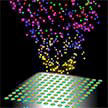 With a new approach, that brings us closer to the commercial application of 3D color holograms, scientists have developed the concept of a virtual 3D color object consisting of colorful focal spots at discrete heights in the out-of-plane dimension above the surface of a print - something they dubbed 'optical fireworks'. Unlike previous 3D color holograms, this color-filtering microlens-based displays realize multicolor and multifocal simultaneously in the form of bright colorful focal spots floating above the prints.
With a new approach, that brings us closer to the commercial application of 3D color holograms, scientists have developed the concept of a virtual 3D color object consisting of colorful focal spots at discrete heights in the out-of-plane dimension above the surface of a print - something they dubbed 'optical fireworks'. Unlike previous 3D color holograms, this color-filtering microlens-based displays realize multicolor and multifocal simultaneously in the form of bright colorful focal spots floating above the prints.
Jun 2nd, 2021
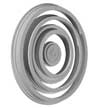 A new generation of lenses - metalenses - is starting to replace bulky curved lenses with simple, flat surfaces that use nanostructures to focus light. These flat surfaces - meatsurfaces - have enabled the design of diffraction-based flat devices to replicate the functionalities of conventional lenses with sub-wavelength or few-wavelength thicknesses. Researchers have now successfully designed and experimentally demonstrated an inverse-designed metalens to operate at a near-infrared wavelength.
A new generation of lenses - metalenses - is starting to replace bulky curved lenses with simple, flat surfaces that use nanostructures to focus light. These flat surfaces - meatsurfaces - have enabled the design of diffraction-based flat devices to replicate the functionalities of conventional lenses with sub-wavelength or few-wavelength thicknesses. Researchers have now successfully designed and experimentally demonstrated an inverse-designed metalens to operate at a near-infrared wavelength.
Apr 8th, 2021
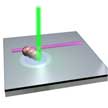 Inspired by chiral molecular structures, scientists are developing strategies to build artificial chiral materials by mimicking natural molecular structures using functional materials. Specifically, metal nanomaterials exhibit tailorable optical properties upon excitation of surface plasmons and become one of the most promising components to realize chiral optical metamaterials. Researchers now demonstrate all-solid-phase reconfigurable chiral nanostructures, where the geometry and chiroptical properties can be dynamically tailored and fully controlled on a solid substrate without liquid media.
Inspired by chiral molecular structures, scientists are developing strategies to build artificial chiral materials by mimicking natural molecular structures using functional materials. Specifically, metal nanomaterials exhibit tailorable optical properties upon excitation of surface plasmons and become one of the most promising components to realize chiral optical metamaterials. Researchers now demonstrate all-solid-phase reconfigurable chiral nanostructures, where the geometry and chiroptical properties can be dynamically tailored and fully controlled on a solid substrate without liquid media.
Feb 1st, 2021
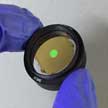 Researchers have developed a high-throughput, scalable nanocomposite printing method to manufacture metalenses at low cost, paving the way to commercializing them. The nanocomposite material, which is also suitable for high-efficiency metasurfaces, can be molded into metalenses just by one step of printing without any secondary operations such as thin-film deposition or plasma etching. The researchers synthesized their nanocomposite by dispersing silicon nanoparticles in the matrix of UV-curable resin to achieve a high-refractive index to increase the efficiency of the metalenses. The printing mold is reusable, so the large-scale metalenses can be printed rapidly and repeatedly.
Researchers have developed a high-throughput, scalable nanocomposite printing method to manufacture metalenses at low cost, paving the way to commercializing them. The nanocomposite material, which is also suitable for high-efficiency metasurfaces, can be molded into metalenses just by one step of printing without any secondary operations such as thin-film deposition or plasma etching. The researchers synthesized their nanocomposite by dispersing silicon nanoparticles in the matrix of UV-curable resin to achieve a high-refractive index to increase the efficiency of the metalenses. The printing mold is reusable, so the large-scale metalenses can be printed rapidly and repeatedly.
Jan 12th, 2021
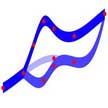 A major challenge for nanophotonics engineers is the wide range of optical responses that metamaterials and other nanoplasmonic structures can generate. In the past few years, machine learning has emerged as a powerful tool for sifting through this vast universe of possible design parameters to aid the design of nanophotonic devices tailored for specific applications. A novel approach uses a type of neural network called a mixture density network to solve the non-uniqueness problem of machine learning algorithms, while also improving accuracy.
A major challenge for nanophotonics engineers is the wide range of optical responses that metamaterials and other nanoplasmonic structures can generate. In the past few years, machine learning has emerged as a powerful tool for sifting through this vast universe of possible design parameters to aid the design of nanophotonic devices tailored for specific applications. A novel approach uses a type of neural network called a mixture density network to solve the non-uniqueness problem of machine learning algorithms, while also improving accuracy.
Sep 17th, 2020
 Ingenious auxetic shape-memory alloy wire lattice textile realizes zone-specified actuation to convey readily discerned complex tactile sensations, enabling intuitive navigation when immersed in virtual environments.
Ingenious auxetic shape-memory alloy wire lattice textile realizes zone-specified actuation to convey readily discerned complex tactile sensations, enabling intuitive navigation when immersed in virtual environments.
 Subscribe to our Nanotechnology Spotlight feed
Subscribe to our Nanotechnology Spotlight feed





